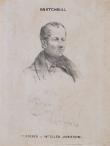John Knatchbull was the son of Sir Edward Knatchbull, High Sheriff and later member of parliament for Kent, and his second wife Frances Graham. One of Sir Edward's nineteen children, John Knatchbull was intended for a naval career. Joining the Royal Navy as a fourteen-year old volunteer in 1804, he saw active service during the Napoleonic Wars, rising to the rank of captain by 1813. Put on half-pay in 1815, Knatchbull was removed from the naval list in 1818, over an accusation by the British vice-consul at Faial that he had refused to pay bills contracted there. He is thought to have served with Thomas Cochrane during the Chilean war of independence against Spain in 1818.
In 1824, Knatchbull was charged with pickpocketing at Vauxhall Gardens in London, convicted, and sentenced to fourteen years transportation. Tried under the alias John Fitch, Knatchbull would claim in his autobiography that he had been framed by his scheming elder brother, who had previously tried to prevent his receiving the inheritance due after the death of their father in 1819. According to Colin Roderick, this claim may have had some basis in fact: the evidence introduced at his trial was not the clearest, and there is reason to suppose that the elder Knatchbull may have wanted his "embarrassing half-brother put away."
After some months on the convict hulk Leviathan, Knatchbull was transported to New South Wales on the Asia in 1824. Briefly assigned to a publican in Lapstone, in the Blue Mountains, he was transferred in 1825 to the agricultural establishment at Emu Plains, and then Bathurst. In 1826, Knatchbull was appointed as a constable for the Bathurst district, his duties including carrying the mail between Bathurst and Mount York once a week. In 1829, he was approved for a Ticket of Leave, allowing him some liberty and to undertake paid work.
Knatchbull's colonial experience took a turn for the worse when in 1831 he was charged with forging a cheque drawn on the Bank of Australia. Found guilty, he was sentenced to death, though the sentence was commuted. Knatchbull was removed first to the Phoenix prison hulk, where he had his first taste of harsh treatment at the hands of the superintendent, Thomas Makeig, against whom he made several allegations that resulted in an official inquiry. In October 1832, Knatchbull was dispatched to Norfolk Island on the Governor Phillip brig. En route, Knatchbull was suspected of being one of the ringleaders of an attempted mutiny. Both Knatchbull, and Thomas Atkins, have claimed that his immediate punishment included being handcuffed to the bowsprit. After an inquiry on Norfolk Island led by the notorious commandant James Thomas Morisset, charges over the attempted mutiny were eventually dropped.
In 1833, Knatchbull suffered a stroke and was left partly paralysed. He was still a minor player in another attempted mutiny in 1834, when a number of Norfolk Island convicts planned to seize the Governor Phillip; Knatchbull's role would be to navigate the ship to America. In the aftermath of the mutiny's failure, Knatchbull became a informer for the Crown prosecution and Foster Fyans, the brutal acting commandant. Fyans was chastised by the Supreme Court Judge William Westbrooke for accepting Knatchbull's deposition rather than trying (and executing) him among the ringleaders of the plot.
In 1839, still six years short of freedom under the revised terms of his colonial sentence, Knatchbull was moved from Norfolk Island to Port Macquarie. In July 1842, while working for a local shipowner, he was granted a new Ticket of Leave for the Port Macquarie area. At this time, he appears to made plans to marry a widowed servant, Harriet Craig, in the process contracting debts he was unable to pay. In January 1844, with the intention of robbery, he murdered a Sydney shopkeeper, Ellen Jamieson.
Swiftly tried and found guilty of the crime, Knatchbull was hanged outside Darlinghurst gaol on February 13, 1844, before a large crowd. While imprisoned awaiting his sentence, he wrote an autobiography which survives in manuscript at the Mitchell Library, State Library of New South Wales.
 754237006698167994.jpg
754237006698167994.jpg